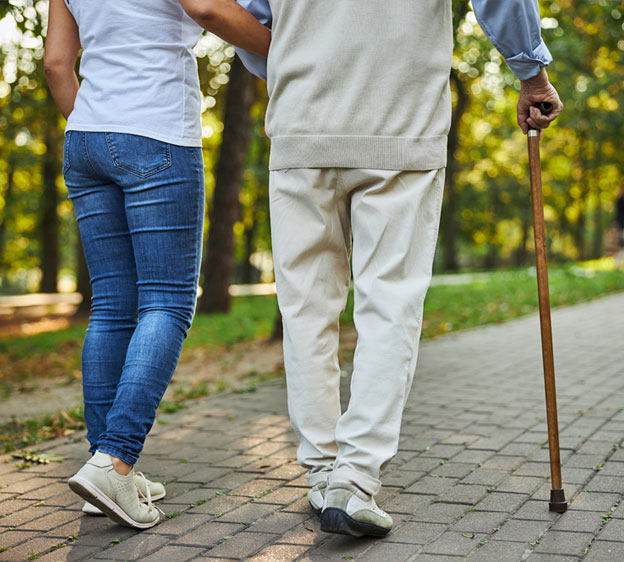
For years, you lived with the pain. As your mobility got worse, you decided to get a new hip or knee. Before you head to the operating room, learn what recovery from joint replacement surgery looks like and how you can make it go smoothly.
“When conservative treatments don’t provide relief, joint replacement surgery could help patients regain mobility and function,” says Andrea Sadler, orthopedic care coordinator and physical therapist at the Beaufort Memorial Joint Replacement Center. “Combine that with our expert physical therapists and a desire to work hard, and you can get back on your feet and back to life fast.”
Read More: Operating Room to Living Room in One Day or Less
Get Started Now
For the best recovery, prepare before heading to the orthopedics operating room. If your joint replacement surgery is coming up soon, do the following:
- Follow your physician’s recommendations. Your surgeon may recommend that you visit the Beaufort Memorial Preoperative Assessment Clinic (PAC) to improve your surgery outcome. The PAC staff will review your medical history, assess your current health status and schedule any additional testing to ensure your safety and readiness for the upcoming surgery.
- Maintain an exercise program before surgery. Recovery from hip or knee replacement typically begins before surgery with prehabilitation, or prehab. At the Beaufort Memorial Joint Replacement Center, for example, several weeks of targeted exercises are prescribed for strengthening surrounding muscles and preparing you for the post-surgical rehab that begins almost immediately after your procedure and is essential to establishing joint stability and range of motion.
- Attend a pre-surgery education class on hip and knee replacements. Beaufort Memorial offers in-person pre-surgery education courses on hip and knee replacements twice a month. During the class, you learn what to expect. You also get an opportunity to ask questions from an orthopedic expert. If you can’t attend in person, we offer online classes for hip, knee and shoulder replacements.
- Make a lifestyle change. If you smoke, now is a good time to quit. Smoking negatively affects circulation and wound healing. It actively works against your recovery, extending it by days, weeks or even months.
- Clean and declutter your home. Rearrange furniture if needed. Following knee or hip replacement, you may have balance issues. Make your home safe with wide walkways and no tripping hazards to keep moving in the right direction.
- Drink up to stay hydrated. Before surgery, your care team may recommend a special pre-surgery beverage. Also, drink plenty of water, as it can prevent dizziness and nausea after surgery. Staying hydrated also helps speed healing.
- Get help around the house. Following surgery, you may have difficulty bathing, cooking and cleaning. Have a loved one stay at home with you as you regain mobility, and ask this person or someone else to drive you to follow-up appointments.
- Install grab bars and other safety equipment. Grab bars in the hallway and bathroom help keep you balanced as you go about daily activities. Sturdy stair rails will help you stay safe when climbing stairs in or around your home.
Read More: When Is the Right Time to Have Knee Replacement Surgery?
During the Early Days
Although recovery begins immediately, and you’ll likely be on your feet the same day as your surgery, we encourage you to be careful. Recovering from knee replacement surgery or hip replacement surgery takes weeks or even months. Full joint replacement surgery recovery can take up to a year. For example, weeks after knee replacement surgery, you won’t be up for much, even if you return home on the day of your surgery. Plan on spending your time resting and healing.
Early on, you may experience the following:
- Pain. Use pain medications as prescribed, and let your care team know if your medication doesn’t do the trick.
- Swelling. There may be puffiness around the replaced joint. Apply ice and keep the affected joint elevated to reduce swelling. Joint replacements should only use cold or ice, never heat. Beaufort Memorial sends patients home with gel ice packs and a wrap.
- Therapy. After you leave the hospital, at-home exercises strengthen the new joint and prevent injury during physical activity. Physical therapy begins a few days after discharge to help get your new joint healthy as soon as possible.
Final Leg of Recovery From Joint Replacement Surgery
Initially, you’ll have therapy sessions two or three times per week. Your therapist reevaluates your progress after a month. If necessary, you may need to continue physical therapy to make the most of your joint replacement surgery.
In most cases, you can return to everyday life after six weeks. Within 12 weeks, your care team allows you to return to work after knee replacement or hip surgery.
Read More: Why Your Hips Hurt: The Answer May Surprise You
Preventing Joint Replacement Surgery Complications
Joint replacement surgery improves life for countless people. While most have a successful recovery, some experience complications. These include blood clots, infection or malfunction of a new joint, or nerve damage.
By staying in contact with your orthopedic care team during the weeks after surgery, you make it easier to detect such problems early. You also prevent complications by following your health care provider’s orders. Take medication, attend physical therapy and return to life gradually, as directed.
Think you could use hip or knee replacement? Sign up for our free Solving Hip and Knee Pain seminar.
